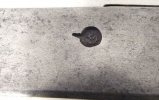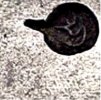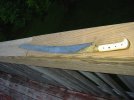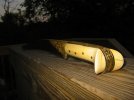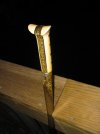- Joined
- Mar 8, 2011
- Messages
- 1,428
Hello All, I’ve had this blade a while & despite posting it on various sub forums haven’t posted it in Swords, so here goes, any comments, opinions or info very welcome.
About twenty years ago I was working at a property being cleared out here in Southern Spain, a skip/dumpster was being filled from a rotten garage with a leaking roof, in it I spied a very rusty sword shape & needless to say it followed me back to my garage.....
I did find out the old owner of the house had travelled extensively but no more details.
It really was rusty & sadly taking photos wasn’t something that occurred to me at that time, what I do remember is it still had the remains of a handle but only just, the flared ears still existed but were fiberous, split & hairy horn pushed off the blade by rust, there was a twisted embossed triangle of brass on one side & some remains of fine brass wire.
At the time it was sword shaped rust so what I did next please forgive me if I ruined a priceless treasure!
I hand sanded the worst of the rust off, pulled much of the hanging off bits from the handle & wrapped it in tape!
And there it hung through the fridge door handle in my workshop for many years, a talking point that many had a swing of...
Maybe ten years ago I’d started handling knives & though I’d make some Oak scales for this, I tried to do something similar to what I thought had been there & it was one of my earliest efforts.
At this point it was still a slightly rusty blade that I always thought was straight carbon steel...
About five years ago reading something made me wonder if it could be pattern welded steel, a test with some Ferric Cloride showed potential..... I bent a piece of PVC pipe & did a few soaks till I got to what’s shown in the images, the pattern is difficult to capture. 28" overall length.
So that’s the (slightly long) story of it!



The white is wax....


The spine is about twice the thickness of the centre of the blade.

About twenty years ago I was working at a property being cleared out here in Southern Spain, a skip/dumpster was being filled from a rotten garage with a leaking roof, in it I spied a very rusty sword shape & needless to say it followed me back to my garage.....
I did find out the old owner of the house had travelled extensively but no more details.
It really was rusty & sadly taking photos wasn’t something that occurred to me at that time, what I do remember is it still had the remains of a handle but only just, the flared ears still existed but were fiberous, split & hairy horn pushed off the blade by rust, there was a twisted embossed triangle of brass on one side & some remains of fine brass wire.
At the time it was sword shaped rust so what I did next please forgive me if I ruined a priceless treasure!
I hand sanded the worst of the rust off, pulled much of the hanging off bits from the handle & wrapped it in tape!
And there it hung through the fridge door handle in my workshop for many years, a talking point that many had a swing of...
Maybe ten years ago I’d started handling knives & though I’d make some Oak scales for this, I tried to do something similar to what I thought had been there & it was one of my earliest efforts.
At this point it was still a slightly rusty blade that I always thought was straight carbon steel...
About five years ago reading something made me wonder if it could be pattern welded steel, a test with some Ferric Cloride showed potential..... I bent a piece of PVC pipe & did a few soaks till I got to what’s shown in the images, the pattern is difficult to capture. 28" overall length.
So that’s the (slightly long) story of it!



The white is wax....


The spine is about twice the thickness of the centre of the blade.

Last edited:








